|
|
|
Sort Order |
|
|
|
Items / Page
|
|
|
|
|
|
|
| Srl | Item |
| 1 |
ID:
148811
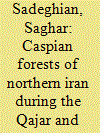

|
|
|
|
|
| Summary/Abstract |
Uniquely among the world’s temperate forests, much of the vegetation of the Caspian forests is now endangered. But while deforestation has accelerated in Iran, these processes were actually underway in the nineteenth century. This article offers a brief introduction to the history of forest exploitation and concessions during the Qajar and Pahlavi periods, addressing actions taken by the Iranian state to protect and extend forest cover, but also the deficiencies of that legislation and the reasons for its failure. Though it is one of the most forested countries in the Middle East, Iran’s forests remain understudied. Existing scholarship mostly addresses the contemporary period; this paper extends the scope of our knowledge, offering a deeper history of forest exploitation in Iran.
|
|
|
|
|
|
|
|
|
|
|
|
|
|
|
|
| 2 |
ID:
090205


|
|
|
|
|
| Publication |
2009.
|
| Summary/Abstract |
Since the 2007 food crisis, controversy has engulfed biofuels. Leading up to the crisis, world-wide interest in these fuels-which include biomass, biogas, bioethanol, and biodiesel-had been surging as states increasingly saw these as a way to meet greenhouse gas reduction targets and promote sustainable economic development. Now some consumers, notably in Europe, are scaling back demand as they worry that biofuels are responsible for increased food prices and deforestation. In contrast, some states-particularly Brazil and the USA, the world's leading bioethanol producers-continue to promote biofuel development, especially in developing countries. Partnerships arising from these efforts, we argue, reflect new patterns in the international political economy, where trade relationships among developing countries are strengthening, and where economic lines between developed and emerging developing countries are blurring. Given previously observed patterns of resource exploitation involving complex webs of North-South and South-South trade (such as for resources like palm oil in Indonesia), we anticipate that the emerging political economy of biofuels will repeat and reinforce many of these same environmentally destructive trends.
|
|
|
|
|
|
|
|
|
|
|
|
|
|
|
|
| 3 |
ID:
102752
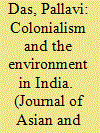

|
|
|
|
|
| Publication |
2011.
|
| Summary/Abstract |
Much of the deforestation seen in the Himalayas today can be traced back to the second half of the 19th century when railway construction began in colonial India. In this paper I argue that the construction and expansion of railways promoted by the British colonial state was designed to enable efficient resource extraction from India and that this process itself depleted India's natural resources such as forests. In analysing the temporal and spatial unevenness of this deforestation in the specific context of the Punjab province I have drawn on government records of various departments, Parliamentary reports, books, scientific journals and newspapers as primary sources.
|
|
|
|
|
|
|
|
|
|
|
|
|
|
|
|
| 4 |
ID:
091444
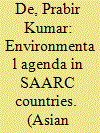

|
|
|
|
|
| Publication |
2009.
|
| Summary/Abstract |
Almost all the countries in South Asia are faced with serious environmental problems, which are nature-made and man-made. Such environmental problems include soil erosion, flood, drought, deforestation, fresh water scarcity, and emission of carbon dioxide in the air and natural disasters.
|
|
|
|
|
|
|
|
|
|
|
|
|
|
|
|
| 5 |
ID:
113982
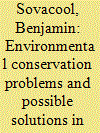

|
|
|
|
|
| Publication |
2012.
|
| Summary/Abstract |
This article explores what the academic literature tells us about environmental conservation challenges in Myanmar, and what types of domestic and international mechanisms are suited to address those challenges. It begins by providing background information on rural energy use, environmental legislation, forestry, agriculture and the country's network of protected areas. It notes, for example, that the country's protected areas face environmental degradation caused by poverty, corruption, the expansion of agricultural land and population growth. It goes on to argue that planners in Myanmar can, however, utilize a variety of mechanisms to overcome these challenges. Policy-makers can enhance community involvement in protected areas and management schemes through ownership and engagement. They could integrate conservation efforts with income generation, provide education and awareness campaigns for those living near wildlife areas and expand the number and size of protected areas. They could, furthermore, increase penalties against illegal activities within protected areas, offer accelerated staff training and education programmes and similarly consolidate regulatory authority for environmental conservation. Even those outside of Myanmar can prevent environmental destruction. International planners could implement ecosystem payments schemes, involve Myanmar more concretely in the Reducing Emissions from Deforestation and Degradation (REDD) process, an international agreement launched in 2012, and expand Myanmar's participation in [End Page 217] the Convention on International Trade in Endangered Species of Wild Fauna and Flora. Lastly, they could advocate international bans on exports of illegal products and strengthen capacity building efforts in the areas of forestry, land use and agriculture.
|
|
|
|
|
|
|
|
|
|
|
|
|
|
|
|
| 6 |
ID:
173471
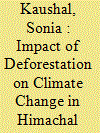

|
|
|
|
|
| Summary/Abstract |
Forests are the richest repository of biodiversity and have evolved to into the complex ecosystem over million years and supports myriad of life forms on earth. Forests not only act as a source to fulfil basic needs of indigenous communities residing in and around areas but economy of any country to a larger extent is based on these forests through revenue generation and provides raw material to the industries.
|
|
|
|
|
|
|
|
|
|
|
|
|
|
|
|
| 7 |
ID:
128421


|
|
|
|
|
| Publication |
2014.
|
| Summary/Abstract |
This paper examines how biomass supply and consumption are affected by land use change in Uganda. We find that between 2007 and 2012 there was a 22% reduction in fuelwood sourced from proximate forests, and an 18% increase in fuelwood sourced from fallows and other areas with lower biomass availability and quality. We estimate a series of panel regression models and find that deforestation has a negative effect on total fuel consumed. We also find that access to forests, whether through ownership or proximity, plays a large role in determining fuel use. We then explore whether patterns of biomass fuel consumption are related to the incidence of acute respiratory infection using a cross-sectional data set of 1209 women and 598 children. We find a positive and significant relationship between ARI and the quantity of fuelwood from non-forest areas; a 100 kg increase in fuelwood sourced from a non-forest area results in a 2.4% increase in the incidence of ARI for children. We find the inverse effect of increased reliance on crop residues. As deforestation reduces the availability of high quality fuelwood, rural households may experience higher incidence of health problems associated with exposure to biomass burning.
|
|
|
|
|
|
|
|
|
|
|
|
|
|
|
|
| 8 |
ID:
135086
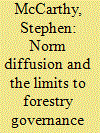

|
|
|
|
|
| Summary/Abstract |
The return of the World Bank Group (WBG) to Burma after some 25 years’ absence, along with other international financial organizations, follows a series of extraordinary political reforms that have taken place in the country since 2010. Burma has made a transition from 50 years of authoritarian rule to what its leaders call ‘disciplined democracy’. This paper examines the likely consequences of the Bank's return for the forestry sector in Burma and the potential outcomes in forestry governance given the evolution of its development agenda over the past 25 years. While measures to address deforestation have been applied in Southeast Asia, the success of forestry governance reforms depends to a large extent on their endorsement and adoption by local power structures and political figures, as well as on the nature of the political regime itself. The record on forestry governance in Southeast Asia is particularly poor and international financial organizations continue to neglect the local political economy of deforestation. Comparatively, few studies have attempted to investigate the relationship between types of political regimes and rates of deforestation. The paper examines two other new democracies in Southeast Asia (Indonesia and Cambodia), and the impact that governance reforms have had on their deforestation trends and land use, in order to contextualize the potential impact of the WBG's return to Burma. In Southeast Asia, powerful vested interests continue to outweigh the support inside governments or civil society for the forestry governance norms promoted by international organizations. The cases of Indonesia, Cambodia and Burma illustrate that deep patrimonial interests operate within the region and that local politics cannot be ignored by international organizations designing policy reforms. The WBG should effectively engage wherever possible with the local communities and a broad range of civil society groups before developing further initiatives.
|
|
|
|
|
|
|
|
|
|
|
|
|
|
|
|
| 9 |
ID:
157405


|
|
|
|
|
| Summary/Abstract |
With their striking flora and fauna and consistently pleasant temperatures, it’s no wonder that the Caribbean islands are often described as paradise. Across the region, ecosystems ranging from high-elevation cloud forests to cactus scrublands boast an incredible array of plants and animals. The Caribbean is also designated as a biodiversity hotspot, which means that its rich natural resources are under threat of destruction. About 70 percent of its original habitats have been lost to natural processes such as water and wind erosion, as well as human activities like deforestation, chemical dumping, and construction. Rising sea levels are another looming menace.
|
|
|
|
|
|
|
|
|
|
|
|
|
|
|
|
| 10 |
ID:
138264
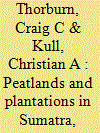

|
|
|
|
|
| Summary/Abstract |
Peatlands play a crucial role in Indonesia's economic development, and in its stated goal of reducing greenhouse gas emissions. Improved peatland management – including a national moratorium on the granting of any new conversion licenses – forms a cornerstone of Indonesia's climate change mitigation commitment. At the same time, rapid expansion of the plantation sector is driving wide-scale drainage and conversion of peat swamp ecosystems. The province of Riau, in central Sumatra, finds itself at the crossroads of these conflicting agendas. This essay presents a case study of three islands on Riau's east coast affected by industrial timber plantation concessions. It examines the divergent experiences, perceptions and responses of communities on the islands. A mix of dramatic protests, localised everyday actions and constructive dialogue has succeeded in delaying or perhaps halting one of the concessions, while negotiations and contestation with the other two continue. With the support of regional and national non-governmental organisations and local government, communities are pursuing alternative development strategies, including the cultivation of sago, which requires no peat drainage. While a powerful political economy of state and corporate actors shapes the contours of socio-environmental change, local social movements can alter trajectories of change, promoting incremental improvements and alternative pathways.
|
|
|
|
|
|
|
|
|
|
|
|
|
|
|
|
| 11 |
ID:
138263
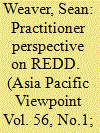

|
|
|
|
|
| Summary/Abstract |
This paper presents a practitioner perspective on community-based REDD (Reducing Emissions from Deforestation and forest Degradation) projects in the Pacific Islands. It draws upon the author's experience in forest conservation financing since 1987, and REDD project and programme design, development and implementation since 2006. The aim is to highlight the commercial challenges faced by REDD practitioners, and explore strategic (including policy) solutions to meet these challenges. The paper begins by situating REDD as a tool for forest conservation and community development. Following a brief overview of the key elements of REDD project development procedures, the paper examines commercial (particularly market access) challenges faced by project proponents, together with challenges associated with the supply and demand dynamic for REDD credits in the global carbon market. This is situated against a backdrop of global policy stagnation in the REDD sector and the implications of this for those at the frontier of community-based forest protection efforts on the ground. The paper culminates by showing the importance of an effective partnership between governments, rainforest communities and the private sector in regional and global rainforest conservation financing.
|
|
|
|
|
|
|
|
|
|
|
|
|
|
|
|
| 12 |
ID:
158346
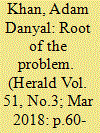

|
|
|
|
|
|
|
|